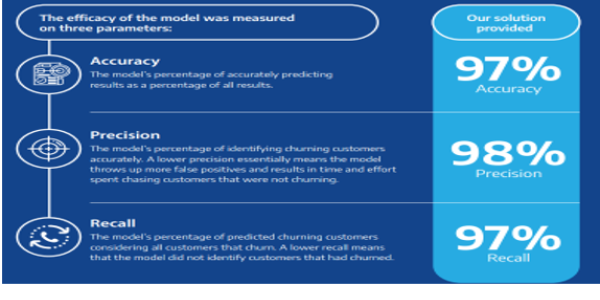More and more organizations are shifting their businesses online as the pandemic accelerates the push for digital. With growing demand for domain registration and web hosting services, the competition has been intensifying, leading to a high degree of customer churn in the industry.
But why do customers churn? What are the factors that make them take their business to a rival? How can service providers identify customers with a high propensity to churn? and take corrective action? We managed to get answers to the above questions for our client
Business Challenge
Our client who is a leading domain name registration and web development company in the US was looking for ways to reduce churn. Over a period of 12 months, the client had lost $46 million in revenue (roughly 10% of its total revenue) to churned accounts and products. Realizing that acquiring a new customer can cost much higher than retaining an existing customer, the client wanted to put in every effort to save significant dollar amount lost to churn.
Around 53% of their customers were pre 2002 when the internet and the web as we know it today was still in its nascency. These customers represented a key focus area for the client as they were on long-term tenured contracts. Even a modest reduction in this segment, either product churn or customer churn or both, would have a visible bearing on revenue performance.
Aeries Solution
- Aeries worked with the client to develop a churn propensity model using data science.
- Based on the evaluation of the problem, machine learning was chosen as the best solution owing to its ability to analyze large volumes of the client’s historic data to spot patterns and trends, and the multiple parameters and attributes that had to be considered.
- Using the model, the Aeries team was able to predict, with a high degree of precision and accuracy, customers with a propensity to churn.
- The model allows sales and marketing teams to put in place the right kind of customer retention strategies and drive personalized campaigns for at-risk customers.
- The solution tailored its recommendations by undertaking a trend analysis of millions of records collected over three years.
- Data science enabled us to analyze thousands of variables and factors that may influence churn in a product category or in customers.
- Customers were scored on their propensity to churn. The scores would start from 10% (least probable) to 90% (most probable).
- This allowed the marketing division of the client to tailor strategies to target those with high propensity to churn and thereby ensure that those customers did not take their business to a competitor.
- Aeries considered a series of factors, which were a combination of internal factors with the client and their response to customers and products as well as industry analysis.
- Some of the key factors that influenced the solution included conversion & onboarding, engagement, retention, renewals, reviews, pricing & profit margin, etc
- The project was divided into three iterations and took around 13 weeks to complete. The project was run 100% virtually due to COVID-19-related restrictions.
Iteration 1-laid the foundation for the solution. We built a base, which provided a snapshot view of the data. At this stage, the data could be filtered by brand, product type, revenue, and geographic location. This was ready within four weeks after the project started.
Iteration 2-considered the time and temporal aspects of the data and included support and outreach provided by the company to its clients. The feature allowed the client to identify any shortcomings in the client’s efforts to retain customers.
Iteration 3-was the final version of the project and was built on top of the earlier two iterations. A key aspect that the final version looked at was product usage. This potentially helped the client identify serious customers, who were using the domains to conduct serious business and generated traffic to their web pages.
Business Impact
- The solution found that customers generally churn due to the following reasons:
- Limited price elasticity
- Poor product/support experience
- Limitations on upscaling
- Business Challenge
- The precision of the system in identifying customers that may potentially churn increased from 84% in Iteration 1 to 97% in Iteration 3.
- The recall rate improved from 76% to 97% during the project’s implementation.
- The model offered them a way to identify at-risk customers and create strategies to retain them.
Key Highlights
- Churn propensity model developed using data science.
- Customer retention strategies and personalized campaigns for at-risk customers.
- Thousands of variables and factors analyzed through data science.







